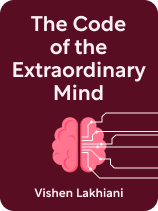

This article is an excerpt from the Shortform book guide to "The Code of the Extraordinary Mind" by Vishen Lakhiani. Shortform has the world's best summaries and analyses of books you should be reading.
Like this article? Sign up for a free trial here.
Are you living by rules that are holding you back? How can you break free from limiting beliefs imposed by society, culture, and your upbringing to create an extraordinary life?
In The Code of the Extraordinary Mind, Vishen Lakhiani offers a framework for questioning inherited beliefs and redesigning your life on your own terms. He provides strategies for developing empowering beliefs, adopting beneficial habits, and finding balance between contentment and aspirations.
Read on for an overview of this book from the cofounder of Mindvalley.
Overview of The Code of the Extraordinary Mind by Vishen Lakhiani
Many of us are unknowingly trapped by inherited beliefs, societal expectations, and unquestioned rules that limit our potential. In The Code of the Extraordinary Mind, Vishen Lakhiani provides guidelines to help you escape from those psychological and cultural restraints to actively recreate your worldview and lifestyle. Ultimately, Lakhiani seeks to empower you to live a happy, purposeful life—and to decide for yourself what such a life looks like for you.
Lakhiani is an entrepreneur, motivational speaker, self-help expert, and a cofounder of Mindvalley, an online education platform that helps people achieve their personal and spiritual development goals. He earned a bachelor’s degree in engineering from the University of Michigan and went to work at a Silicon Valley startup, but quickly burned out. Lakhiani then traveled the world, studying meditation and teaching. In 2016, he published the book The Code of the Extraordinary Mind to condense what he had learned as both a student and a teacher into a guide that anyone can use to pursue their dreams; the book quickly became a New York Times best seller.
In this overview of Lakhiani’s The Code of the Extraordinary Mind, we’ll explain why redesigning your life must start with examining the beliefs and goals your upbringing imposed on you, and how to do that effectively. We’ll then describe Lakhiani’s two-pronged approach to self-improvement: developing more empowering beliefs, and improving your life in practical ways by adopting beneficial habits. To conclude, we’ll discuss how to achieve Lakhiani’s ideal state of mind—one in which you’re both content with your present circumstances and excited about future possibilities.
Examining Your Past to Change Your Future
Lakhiani’s first step toward building the life that’s best for you is to free yourself from the societal and personal baggage that’s holding you back.
We’ll start this section by discussing how your culture may have influenced your beliefs and expectations about life, and the importance of letting go of those assumptions. We’ll then go over Lakhiani’s process for questioning the rules you live by, so you can get rid of the rules that don’t hold up to scrutiny.
Looking Beyond Your Upbringing
The first step toward creating your ideal life is to recognize that many of your beliefs aren’t based on objective, universal truths. Lakhiani explains that your understanding of the world has been fundamentally shaped by your culture and upbringing: the social practices, beliefs (religious or otherwise), and even the language that you inherited just by growing up when and where you did. For instance, in gendered languages such as Spanish (which uses the masculine “el” and feminine “la” as opposed to English’s neutral “the”), speakers tend to apply masculine or feminine qualities to objects accordingly. This is just one of the countless ways that cultural influences shape people’s worldviews.
Furthermore, Lakhiani argues that most people accept whatever worldview they inherit without ever stopping to examine it. This is because, once you accept something as true, you simply see it as a fact rather than as a personal belief. Therefore, you don’t tend to reconsider your inherited beliefs, in much the same way that you never “reconsider” whether ice is actually cold.
However, such unquestioning acceptance can limit you in ways you don’t realize. This is because you won’t strive for something you assume is impossible or morally wrong, without realizing that the beliefs leading you to those assumptions could be flawed themselves.
Questioning the Rules You Live By
After recognizing that your upbringing has left you with false, limiting beliefs, you can start the process of critically examining the rules and expectations that others have set on you. Questioning the unwritten rules you live by, and discarding the ones that don’t serve you, is a major step toward reinventing your life.
Lakhiani says that nearly everyone follows some harmful or limiting rules that are based on flawed, subjective ideas about the world. He refers to these as Brules, which is a portmanteau of “bulls**t rules.” Such rules can manifest in almost every aspect of life, like your career choices, relationships, and goals.
For instance, many people have kids simply because that’s what their culture has told them to do. They follow the “rule” that they must get married and create a family. Because they never questioned the idea that they’re supposed to have children, such people end up trapped in parenting roles they never wanted. This can leave them (and often their children as well) deeply unhappy for many years.
With that said, it’s important to note that a lot of rules do have good reasons behind them. For example, many rules exist because they help people get along with each other, guide them through difficult or dangerous situations, and keep society functioning smoothly. Therefore, it’s not enough to simply identify the unwritten rules that guide your actions—before discarding any such rule, it’s important to examine that rule carefully to see whether it still serves an important purpose.
Committing to Lifelong Personal Growth
Once you’ve deconstructed your limiting beliefs, you’re ready to begin rebuilding your mindset and worldview in ways that better serve your happiness.
In this section we’ll discuss how you can continuously improve your mindset and the benefits of doing so. We’ll then explore what Lakhiani believes is the ideal mindset, a balance between being happy with the present and being excited about the future.
Updating Your Mind
Lakhiani—who started his career in Silicon Valley—says the human mind works a lot like a computer. As such, you need regular updates in order to stay current and optimize your mental performance. He therefore proposes a continuous, lifelong process of personal development focused on two areas: your mental hardware (beliefs) and mental software (habits).
We’ve already discussed the first area of improvement, which are your beliefs. Continuing the computer metaphor, Lakhiani refers to beliefs as your mental computer’s hardware: What you believe determines what you can do, just like a computer’s components determine which programs it’s able to run. So, after you “upgrade your hardware” by overcoming a limiting assumption or adopting an empowering belief, you’ll find that you can do things you previously thought were impossible.
The second area of improvement is your habits, or your mental software. This is all about finding practical ways to improve your life by overcoming bad habits and adopting good ones. The software metaphor emphasizes that improving your habits will be difficult, perhaps impossible, if the improvements you try to make go against your beliefs. For example, if you want to lose weight but don’t believe that you’re capable of cutting back on eating, you’ve created a self-fulfilling prophecy: You don’t believe you can eat less, so you won’t eat less, so you won’t lose the weight.
Empowering Yourself
We’ve discussed the importance of constantly updating your beliefs and habits, but Lakhiani also says that it’s important to do so in the right ways. Specifically, to update your mental models in ways that make you feel powerful and self-assured. There are two separate categories to concern yourself with.
The first category, and the more obvious of the two, is how you view yourself. The author suggests that you practice self-empowerment by taking a few minutes each day to remember what you love about yourself. For instance, maybe you’re a hard worker, or a kind and generous person, or you have really attractive eyes.
You can also think about things you’re proud of doing. This could be something as impressive as winning a prestigious award, or as mundane as offering a ride to someone who needed it. In short, anything that helps you remember how great you really are will improve your self-image.
The second category, which is equally powerful, consists of your mental models about how the world works. However, these external models can be harder to update. This is because doing so involves thinking about what you’ve observed and learned, then filtering through those observations to find useful, empowering insights.
For example, young people may think that you have to be wealthy or attractive to find a great romantic partner. However, by thinking rationally about the couples they’ve personally seen, they’d realize that people of all different economic classes and body types can and do end up in happy relationships. With that update to their worldview, they could then realize that it’s also possible for them to find such a relationship.
Evaluating Your Progress
Lakhiani promises that your life will improve in numerous ways as you continually update your beliefs and habits. However, it’s likely that some aspects of your life will improve less than others, and you may still find yourself dissatisfied in some ways. To help correct this imbalance, the author provides a rubric for assessing the various areas of your life, so that you can give extra attention to updating relevant beliefs and habits.
For this evaluation, Lakhiani wants you to rate each of the following aspects of your life on a scale from 1 (very dissatisfied) to 10 (completely satisfied):
- Your love life
- Your friendships
- Your finances
- Your environment—the quality of your home, car, workspace, and so on
- Your health
- Your learning habits—how much and how often you’re learning
- Your emotions—how happy you feel
- Your spirituality, including practices such as meditation and connecting with nature, not just religion
- Your career, including future career opportunities
- Your self-image—how satisfied you are with yourself
- Your family relationships
- Your contributions—how much you’re making the world a better place
Once you’re done, Lakhiani urges you to choose one or two areas that you’d like to focus on improving. Don’t try to work on every aspect of your life at once because that’s likely to be overwhelming and discouraging.
Balancing Present Contentment With Future Anticipation
As you continue to update your beliefs and habits, Lakhiani promises you’ll move closer to an ideal state of being—one where you’re happy in the present moment and yet excited about the future.
This is a difficult balance to strike, and the author says that finding it requires moving away from the traditional idea that your happiness comes from achieving major life goals. Instead, create a bold and exciting vision of your future, but recognize that you can be happy while working toward it. By separating your concept of happiness from your vision of the future, you can be content with your life as it is, yet still look forward to even better things to come.
For example, becoming a millionaire is a fairly common life goal, and people pursue it because they think wealth will make them happy. However, in the process, they often make themselves miserable by devoting their lives to jobs they hate, just because those jobs pay well. If such a person were to recognize that becoming a millionaire isn’t actually a prerequisite for being happy, they could find a job that suits them better (even if it pays less). By doing so, they could start to find contentment in the present, while still looking forward to the day when their wealth crosses that million-dollar threshold and seeking out ways to make that happen.
Training Yourself to Be Happy
The first part of striking this balance is finding happiness in your present circumstances, whatever they may be. Lakhiani argues that this is possible because happiness is a skill you can practice—or, more accurately, a set of three skills that he urges you to practice daily.
The first skill is thankfulness. Lakhiani suggests that you spend a few minutes each morning and evening thinking about what you’re grateful for, both in your personal life and your professional life. It doesn’t matter whether anyone else would think these things are important or worth celebrating, as long as they’re meaningful to you. For each one you think of, take a few moments to deeply feel and appreciate the positive feelings it creates within you.
The second skill Lakhiani urges you to practice is letting go. Many of us hold onto anger and grudges for past wrongs and sabotage our happiness by doing so. Letting go of those negative feelings is crucial for creating real, lasting contentment.
Lakhiani’s process for letting go of anger is similar to the previous skill. Begin by closing your eyes and remembering the event that upset you as clearly as possible and the person or people responsible for it. Allow yourself to fully feel the hurt and anger of being wronged. However, don’t remain in this state for more than a few minutes, or you run the risk of reinforcing your grudge rather than working through it.
Finally, try to find feelings of compassion regarding what happened to you. Consider what might have led the other person to act the way they did, and whether you’d have done any better in their position. You can also consider how the experience might have taught you an important lesson or spurred you to become a better person in some way.
Lakhiani warns that you may need to repeat this process many times to fully let go of the negativity, but promises that you’ll feel a bit better with each repetition. Eventually you’ll reach a point where you’re comfortable forgiving the person and moving on from what happened.
The third skill is contribution, which means helping others and making the world better. Lakhiani explains that people tend to think of “helping” only in terms of either doing physical labor or donating money, but there are many other ways you can contribute to others’ well-being. For example, you could teach professional or life skills that you excel in, and give advice based on exceptional experiences you’ve had (good or bad). There are also opportunities to help out in your local community, such as volunteering at a community center or joining a neighborhood cleanup crew.
Designing Your Own Version of Success
We’ve discussed how you can become content in the present; the other part of Lakhiani’s ideal mindset is excitement about the future. To cultivate that sense of anticipation, he recommends rebuilding your personal vision of success from the ground up and designing a future you can truly look forward to.
Do this by thinking about three important questions.
1. “What do I want to experience?” If you had the personal and financial freedom to do anything you wanted, what kinds of experiences would you seek out? For example, some people dream of traveling the world, while others imagine a quiet life as the owner of a local shop or as a stay-at-home parent.
2. “Who do I want to be?” Consider what kind of person you’d need to be in order to live out your answers to the previous question. Also think about what changes you’ll need to make—what kinds of personal development you’ll have to undergo to get from the person you are to a person who can have those experiences. Continuing the previous examples, if you want to travel the world, you most likely need money and courage, and few personal commitments keeping you home. On the other hand, to start a small business or raise a family, you need to be someone who can fully devote yourself to those kinds of responsibilities.
3. “How do I want to help?” Remember that the third happiness skill Lakhiani urges you to develop is contribution. Therefore, your answer to this question will help guide you toward both present contentment and future excitement. Try thinking about it in two parts: how you can help others every day starting now, and how you can help others after you’ve become the person you envisioned in question #2.

———End of Preview———
Like what you just read? Read the rest of the world's best book summary and analysis of Vishen Lakhiani's "The Code of the Extraordinary Mind" at Shortform.
Here's what you'll find in our full The Code of the Extraordinary Mind summary:
- The psychological and cultural restraints that every person is trapped in
- How to examine your ideas and where they originated from
- How to discard the beliefs that no longer serve you






